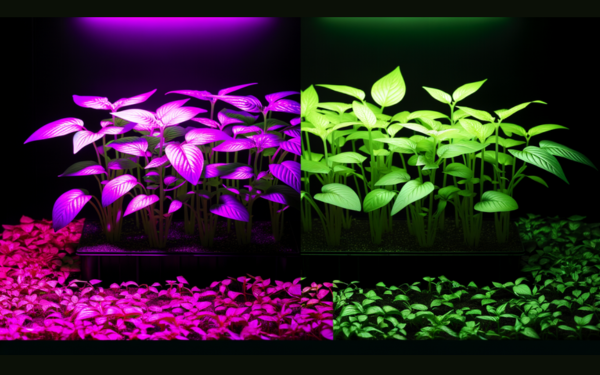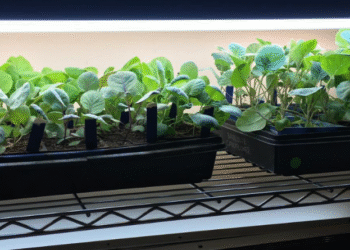In controlled environment agriculture (CEA), optimizing flavor and aroma has often taken a backseat to maximizing yield and growth rate. However, with consumer demand rising for high-quality, nutrient-dense, and flavorful produce, researchers and growers are revisiting spectral strategies. While most LED grow lights focus on photosynthetically active radiation (PAR: 400–700 nm), emerging evidence highlights the powerful, yet underutilized, roles of ultraviolet (UV) and far-red wavelengths. These lie outside the PAR range but interact directly with plant photoreceptors and metabolic pathways responsible for secondary metabolite production—key contributors to flavor and aroma.
Practical Applications: UV LEDs for Flavors, Aromas, and Nutraceuticals
Research in crops like lettuce, tomatoes, strawberries, and medicinal herbs (e.g., basil, cannabis) demonstrates that low-dose UV light can increase concentrations of flavonoids, terpenes, and phenolics—compounds that define flavor, aroma, and antioxidant properties.
Key findings:
- Basil: UV-B increases eugenol and linalool concentrations, improving aroma intensity.
- Tomatoes: UV-A application near harvest raises quercetin levels without reducing yield.
- Cannabis: Targeted UV-B treatments enhance terpene diversity and potency of cannabinoid profiles.
Grower implications:
Modern LED grow lights with UV channels allow for controlled, timed applications—often during late vegetative or pre-harvest phases. This minimizes stress damage while maximizing biosynthesis of desirable secondary metabolites.
When selecting UV-capable LED luminaires, it’s crucial to ensure low-wavelength accuracy (280–315 nm for UV-B) and irradiance consistency across the canopy to avoid phototoxicity.
Leveraging Far-Red for Morphology and Aroma Optimization
Far-red light interacts with phytochrome receptors (mainly PhyA and PhyB), altering photomorphogenic responses. While excessive far-red can trigger shade-avoidance, strategically timed or localized application can yield targeted outcomes.
Research-based outcomes:
- Tomatoes: End-of-day far-red (EOD-FR) light enhances sugar accumulation and lycopene concentration.
- Strawberries: Increased floral initiation and aroma intensity under far-red enrichment.
- Peppermint and lavender: Elevated monoterpene levels, improving aromatic profile.
Best practices:
- Apply far-red during early flowering to accelerate photoperiod-sensitive species.
- Use EOD-FR lighting to manipulate flowering without affecting internode distance excessively.
- Balance red: far-red ratios using tunable LED luminaires to avoid stem elongation.
This spectrum is especially valuable for high-value crops where flavor or fragrance drives consumer preference.
Integrating UV and Far-Red in LED-Based Spectral Recipes
One of the biggest advantages of modern LED horticultural lighting solutions is spectral flexibility. Tunable LED grow lights allow researchers and growers to design light “recipes” tailored for specific physiological responses, enabling a shift from generalized lighting to crop-specific and even cultivar-specific light strategies. Valoya’s new LL-CV Series takes this further by allowing users to mix and match fixture lengths and spectra on a single driver, ensuring tailored lighting configurations for varied applications—from growth chambers to greenhouses.
Implementation recommendations:
- Use programmable LED luminaires with discrete control over UV, far-red, and PAR bands.
- Conduct trial runs on select crop batches to identify optimal dose–response relationships.
- Monitor physiological indicators (leaf temperature, pigment ratios, VOCs) with sensors to calibrate treatments.
- Consider integrating UV/far-red into existing SOPs for flavor-sensitive crops such as leafy greens, herbs, or medicinal plants.
This approach supports both scientific experimentation and scalable commercial use.
To Wrap Up
UV and far-red LEDs represent a powerful extension of modern horticultural lighting solutions. When applied with intent, they allow growers and researchers to manipulate secondary metabolism and unlock new dimensions of crop quality, particularly flavor and aroma.
High-quality horticulture lights that include these spectra—especially in programmable LED grow lights—offer targeted control over plant biochemistry. For researchers, this presents opportunities to explore underutilized light-induced mechanisms. For commercial growers, it offers a clear path to differentiate produce in premium markets where sensory attributes command higher value.
In short, UV and far-red are no longer optional, they are essential tools for modern, quality-focused cultivation.



















